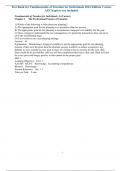Test Bank for Fundamentals of Taxation for Individuals 2024 Edition Carnes
All Chapters are included
Fundamentals of Taxation for Individuals, 1e (Carnes)
Chapter 1 The Professional Practice of Taxation
1) Which of the following is false about tax planning?
A) The appropriate goal for tax planning is to maximize after-tax income.
B) The appropriate goal for tax planning is to minimize a taxpayer's tax liability for the year.
C) Once a taxpayer understands the tax consequences of a particular transaction, they can move
on to the tax planning stage.
D) Tax evasion is not a tax planning strategy.
Answer: B
Explanation: Minimizing a taxpayer's liability is not the appropriate goal for tax planning
because if that were the goal, then the ultimate success would be to reduce a taxpayer's tax
liability to zero–actually an easy goal to meet. If a taxpayer has no income for the year, then
there would be no tax liability, and you will have minimized their taxes. But your client will also
be a very poor and hungry person, so this cannot be the proper goal.
Diff: 1
Learning Objective: LO 1.1
AACSB / AICPA: Knowledge / Accounting Competencies
Bloom's: Knowledge
Section Reference: Sec. 1.1
Time on Task: 5 min
1
, 2) Jessica has received several job offers from various accounting firms located in 4 different
states. She has performed an analysis to determine her income, her non-income tax costs (e.g.
cost of living, etc.) and income tax. Jessica is trying to make a decision on which offer to accept,
and she has asked for your advice. Based on the appropriate goal of tax planning, which of the
following states would you advise Jessica to choose?
Gross Wages Non-Income Tax Costs Income Tax
California 120,000 52,000 24,000
New York 100,000 37,000 20,000
Virginia 70,000 10,800 10,500
Texas 50,000 6,000 5,000
A) Texas
B) California
C) Virginia
D) New York
Answer: C
Explanation: The appropriate goal for tax planning is to maximize after-tax income. After-tax
income is net income after reducing revenue for all expenses, including federal income taxes.
See table below for calculation of after-tax income for each state. With that in mind, you should
advise Jessica to choose Virginia because doing so maximizes her after-tax income. The state
with the lowest income tax (i.e., Texas) is not the right answer because minimizing a taxpayer's
liability is not the appropriate goal for tax planning because if that were the goal, then the
ultimate success would be to reduce a taxpayer's tax liability to zero–an easy goal to meet. If a
taxpayer has no income for the year, then there would be no tax liability, and you will have
minimized their taxes. But your client will also be a very poor and hungry person, so this cannot
be the proper goal.
Gross Non-Income After-Tax
Wages Tax Costs Income Tax Income
(A) (B) (C) (D) = (A) - (B) - (C)
California 20,000 52,000 24,000 44,000
New York 100,000 37,000 20,000 43,000
Virginia 70,000 10,800 10,500 48,700
Texas 50,000 6,000 5,000 39,000
Diff: 2
Learning Objective: LO 1.1
AACSB / AICPA: Analytic / Accounting Competencies
Bloom's: Application
Section Reference: Sec. 1.1
Time on Task: 8 min
2




